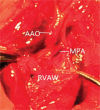Prenatal ultrasonic diagnosis of absent pulmonary valve syndrome: A case report
- PMID: 28858090
- PMCID: PMC5585484
- DOI: 10.1097/MD.0000000000007747
Prenatal ultrasonic diagnosis of absent pulmonary valve syndrome: A case report
Abstract
Rationale: Absent pulmonary valve syndrome (APVS) is a rare congenital heart disease that is often associated with tetralogy of Fallot (TOF). Here, we report 2 cases of APVS associated with TOF diagnosed via fetal echocardiography and discuss their specific ultrasonographic characteristics.
Patient concerns: Two pregnant women with suspicion of fetal heart anomaly were referred from their local hospitals to our hospital for fetal malformation screening and detailed fetal echocardiography. Color and spectral Doppler flow imaging were utilized to evaluate the axis, size, situs, cardiac chambers, and both inflow and outflow tracts of the heart as well as the great arteries. Both cases had a severe dilatation of the pulmonary trunk and its branches and an absence or dysplasia of the pulmonary valve, which was associated with subaortic ventricular septal defect (VSD) with an overriding aorta. In addition, the fetus in case 1 showed a patent ductus arteriosus, and the fetus in case 2 showed arterial duct agenesis. Furthermore, color Doppler flow imaging showed a bi-directional multicolored flow signal in the pulmonary valve ring.
Diagnoses: Both fetuses were diagnosed with APVS associated with TOF.
Interventions: No therapeutic intervention was performed.
Outcomes: On the request of the pregnant women and their families, both fetuses were aborted.
Lessons: Although APVS is a rare congenital heart disease and often associated with TOF, it has an overall poor prognosis. Nowadays, it can be easily diagnosed via ultrasonography because of its typical ultrasonographic features, such as aneurysmal dilatation of pulmonary artery, massive regurgitation of the pulmonary valve, VSD, and an overriding aorta. Therefore, early fetal echocardiography screening should be performed for every fetus.
Conflict of interest statement
The authors have no funding and conflicts of interest to disclose.
Figures



References
-
- Wertaschnigg D, Jaeggi M, Chitayat D, et al. Prenatal diagnosis and outcome of absent pulmonary valve syndrome: contemporary single-center experience and review of the literature. Ultrasound Obstet Gynecol 2013;41:162–7. - PubMed
-
- Szwast A, Tian Z, McCann M, et al. Anatomic variability and outcome in prenatally diagnosed absent pulmonary valve syndrome. Ann Thorac Surg 2014;98:152–8. - PubMed
-
- Becker R, Schmitz L, Guschmann M, et al. Prenatal diagnosis of familial absent pulmonary valve syndrome: case report and review of the literature. Ultrasound Obstet Gynecol 2001;17:263–7. - PubMed
-
- Lato K, Gembruch U, Geipel A, et al. Tricuspid atresia with absent pulmonary valve and intact ventricular septum: intrauterine course and outcome of an unusual congenital heart defect. Ultrasound Obstet Gynecol 2010;35:243–5. - PubMed
-
- Philip S, Varghese M, Manohar K, et al. Absent pulmonary valve syndrome: prenatal cardiac ultrasound diagnosis with autopsy correlation. Eur J Echocardiogr 2011;12:E44. - PubMed
Publication types
MeSH terms
LinkOut - more resources
Full Text Sources
Other Literature Sources

